Digital done differently.
Modeling done flawlessly.
Casio’s phase distortion synthesis was a relative of FM but simpler to use, achieving patches that sounded both ‘digital’ and ‘analog’ with equal ease.
It became a sonic staple for artists including Eurythmics, Salt-N-Pepa, and Vince Clarke (Depeche Mode, Yaz, Erasure), who famously stacked up eight CZ-101 synths and a sequencer. CZ V gives you more of what the CZ was loved for in every way – and more.
Expertly Engineered
Our DSP crew reverse-engineered the core code of the CZ, then added features to make phase distortion even more compelling today.
Shockingly Flexible
The CZ series is used on all kinds of songs because it produced so many sounds so well. Let CZ V do the same for you.
CZ = EZ
Wringing a ton of sonic range out of just a handful of parameters, CZ V is one of the quickest paths from a sound in your head to sound in your speakers.
Turbocharged
We amped up the CZ with up to 32 voices of polyphony, four FX slots, eight envelopes, and everything but a flux capacitor.
More than just
a phase
The CZ-101 defined a whole new way of creating the sounds keyboardists and producers wanted. This put Casio® on the map as a maker of serious professional synthesizers. CZ V puts phase distortion back on the map with the ultimate version of this groundbreaking synthesis technology.
In the early ’80s, Casio wasn’t about to sit still while the DX7 took over the world. Fortunately, they had a platform to build on — a high-end synth workstation called Cosmo. It’s the direct ancestor of the CZ-101, whose mini keys and $499 price tag put real synthesis in the hands of a new generation of musicians.
Discover the history of CZ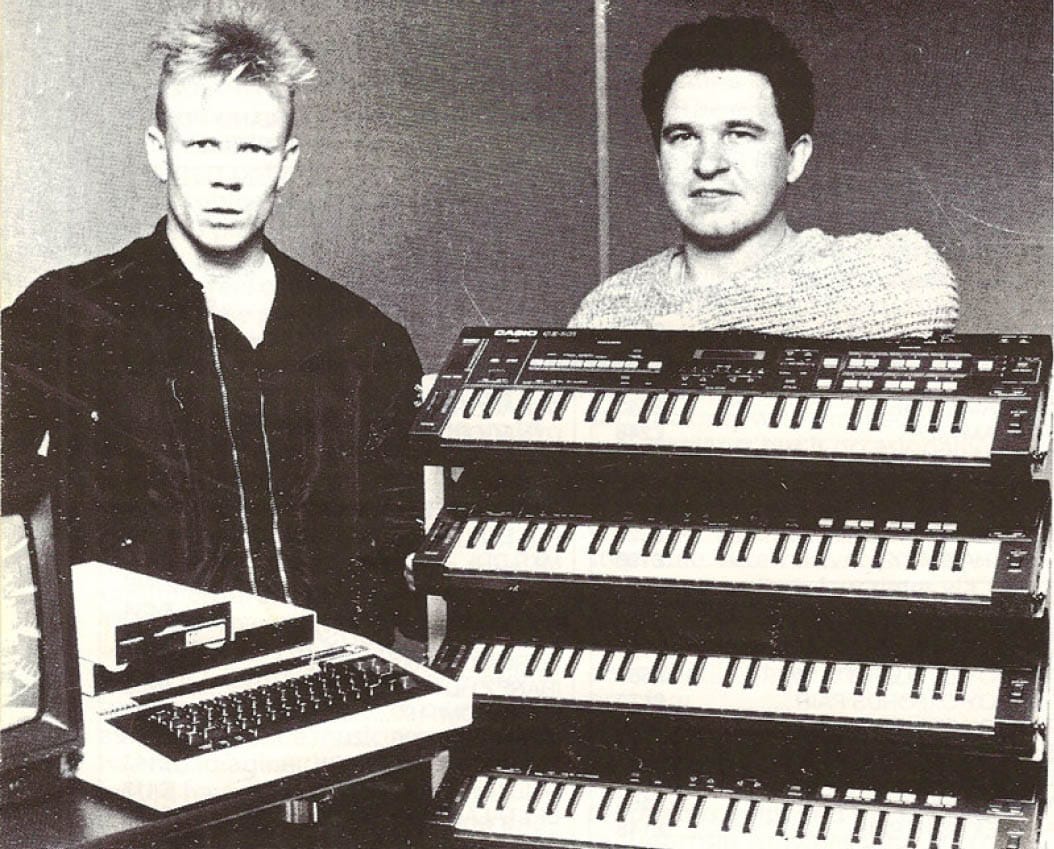
A different kind of
of distortion
Phase distortion, like FM, involves one oscillator modulating another.
Phase distortion's uniqueness comes into play by altering the time domain of the carrier wave, yielding a different oscillator wave shape entirely. By changing the linearity of how a simple waveform plays, like speeding up the start of the cycle, it’s no longer a simple waveform. That’s the concept at the heart of phase distortion synthesis and CZ V’s sound.
DCO > DCW > DCA
Each DCO in CZ V lets you select from the 8 original waveforms or draw your own. Some serial combinations of two different waveforms are provided for, resulting in many more possibilities. Each DCO is followed by a corresponding digitally controlled waveshaper (DCW) section, including key follow and an 8-stage envelope generator. This animates the amount of waveshaping from the modulator over time. There’s also an eight-stage envelope for DCO frequency, allowing for pitch-change effects far beyond vibrato, trills and lasers. A digitally controlled amplifier (DCA) with its own eight-stage envelope rounds out a DCO>DCW>DCA signal chain roughly equivalent to that of analog VCO>VCF>VCA.
Between the lines
Like the original, the CZ V has two complete DCO>DCW>DCA signal lines that you can use individually or in parallel. Duplicate settings in each line allows for a fatter sound given the ability to transpose and/or detune them, while separate settings provide for much more complex timbres. You might, for example, shape a hyper-percussive sound in one line and craft a pad in the other to combine into a compound timbre. Other goodies faithful to the original include a dedicated vibrato section, polyphonic portamento, ring modulation and noise modulation.
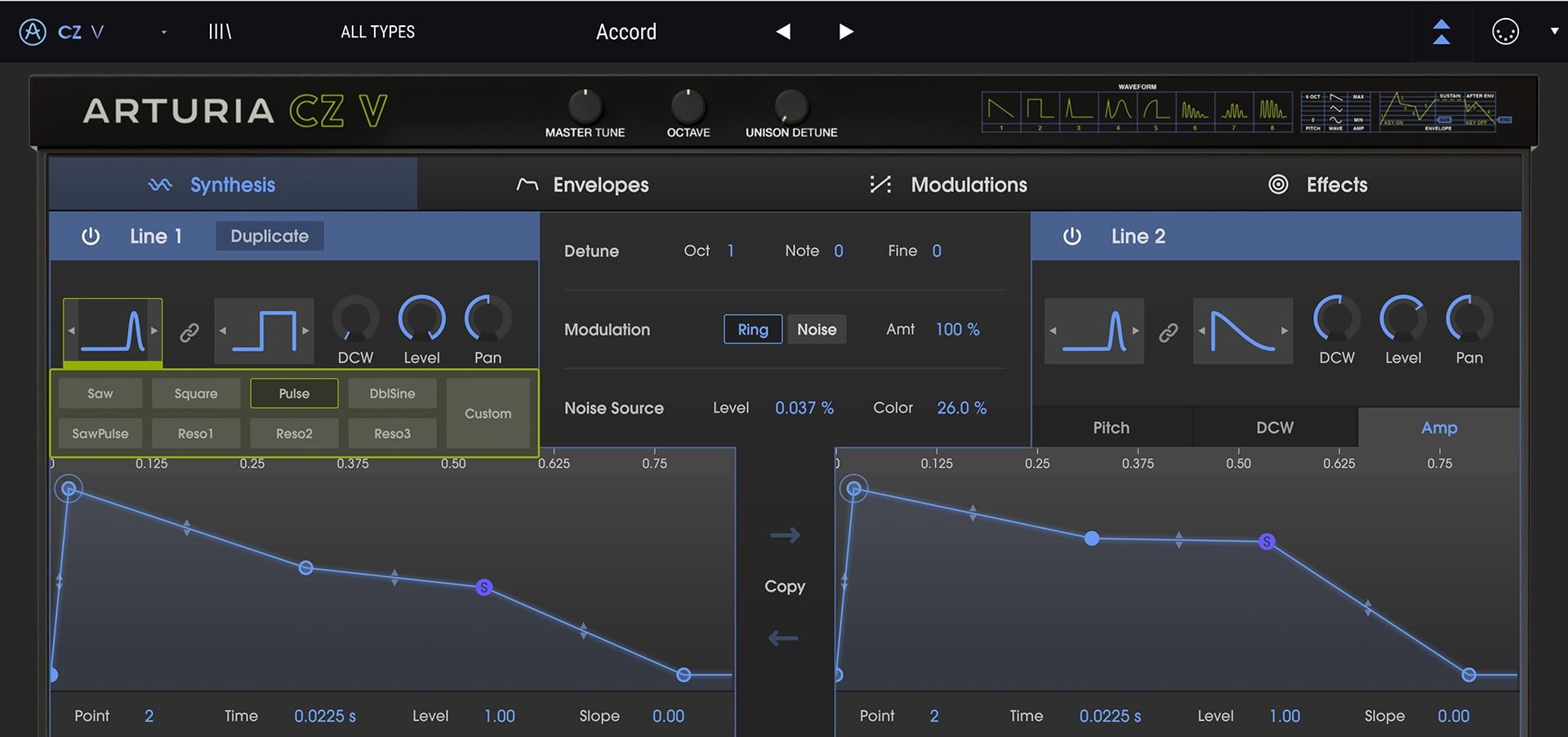
Simple Synthesis
Ultimately, the beauty of PD compared to the better-known FM is that there are only four primary things that really control the timbre of each CZ line: the DCO’s modulating waveform and the three envelopes. Both PD and FM have made significant and instantly recognizable contributions to music, but the simpler concept of PD can ironically get a lot closer to analog bass, brass, strings and more with a lot less fiddling.
Our DSP team reverse-engineered the code inside the CZ-series and even modeled the DAC outputs, delivering the perfect combination of authentic PD behavior and that crunchy, almost-lo-fi sound of the ‘80s, right in your DAW.
A CZ for
Today
The CZ-101 had an instant and intuitive interface, especially for an early digital synth - yet CZ V is quicker and more performance-oriented in every way.
Everything you need for breathtaking tracks and gig-ready sounds is arranged for maximum connection between thoughts, hands, and music.
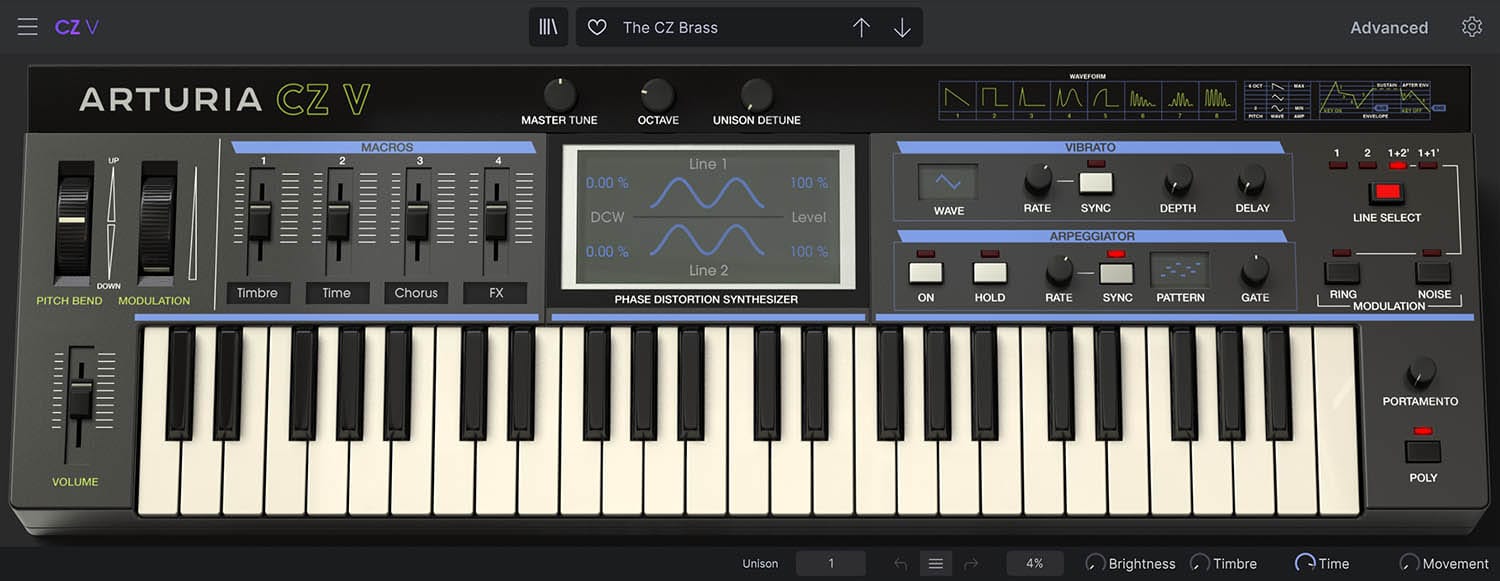
_1
_2
_3
_4
_5
_6
01. Eyes Meet Ears
See exactly what’s happening to your sound as you play and the waveforms morph, right in the central display area.
02. Drop the Bass, Tweak the FX
Four sliders can each control multiple parameters at once for performance gestures from subtle to drastic.
03. Dedicated Vibrato
We’ve upgraded the CZ’s stand-alone vibrato section with more waveforms, tempo sync, and adjustable delay.
04. Guilty Pleasure Generator
What would an ’80s synth be without a classic arpeggiator? Ours features six patterns (including as-played and random) and up to a 4-octave range.
05. Line Up
Choose to hear Line 1, Line 2, both, or Line 1 plus a copy of itself. Then, ring- or noise-modulate them here.
06. Poly or Mono
Toggle into mono mode for thick unison leads on solos, then back to poly for playing chords, with one button.
A CZ for
Tomorrow
Massive synthesis power lurks just beneath the surface in CZ V’s Advanced Panel. We’ve made all of it fun and easy to use.
If this much capability had been packed into hardware, phase distortion might have become the dominant synthesis method in music. Our Advanced interface makes it more intuitive than ever to see just how far PD can go.
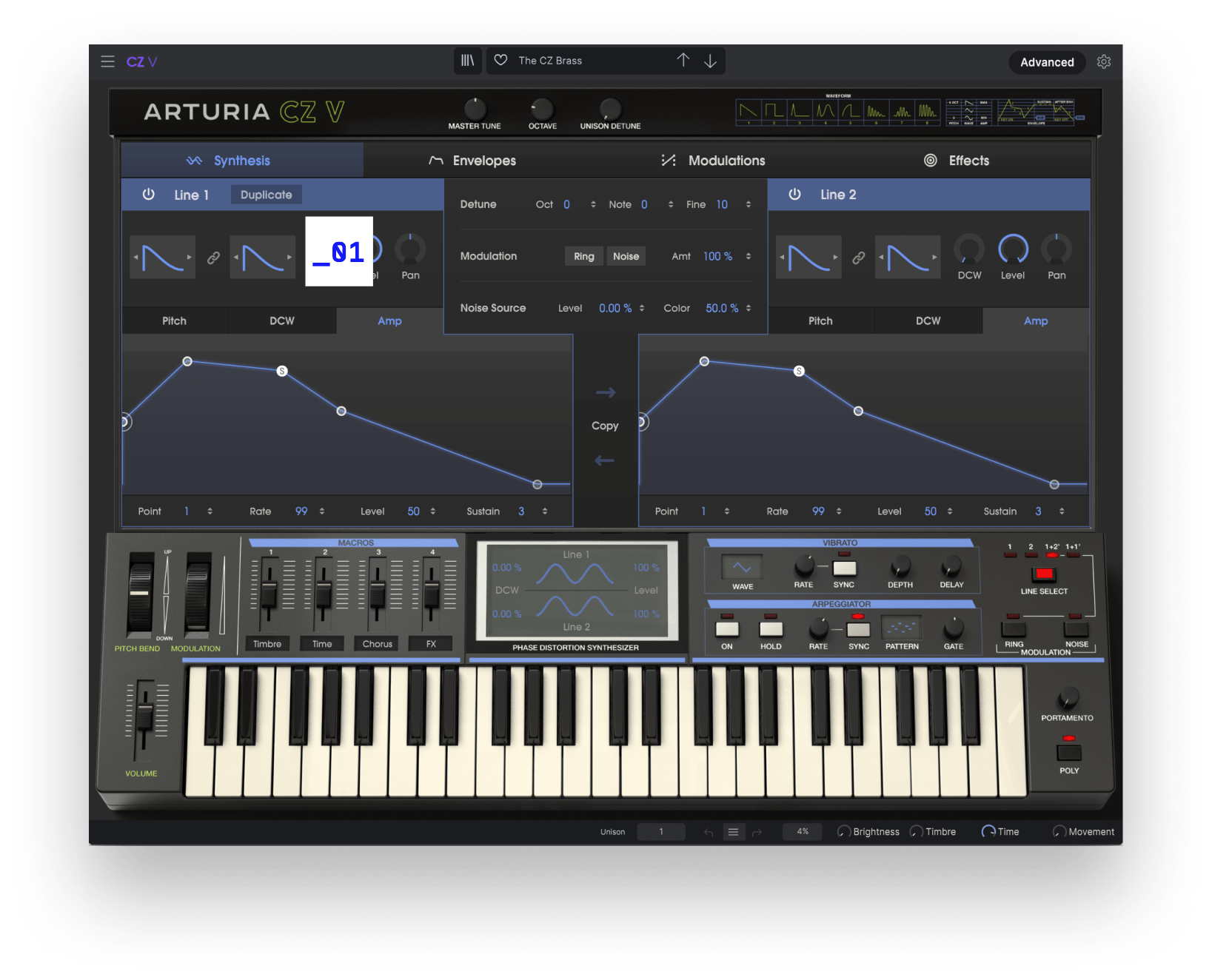
With different target waveforms for the first and second cycle in each Line, creating ear-grabbing harmonic motion is a snap!
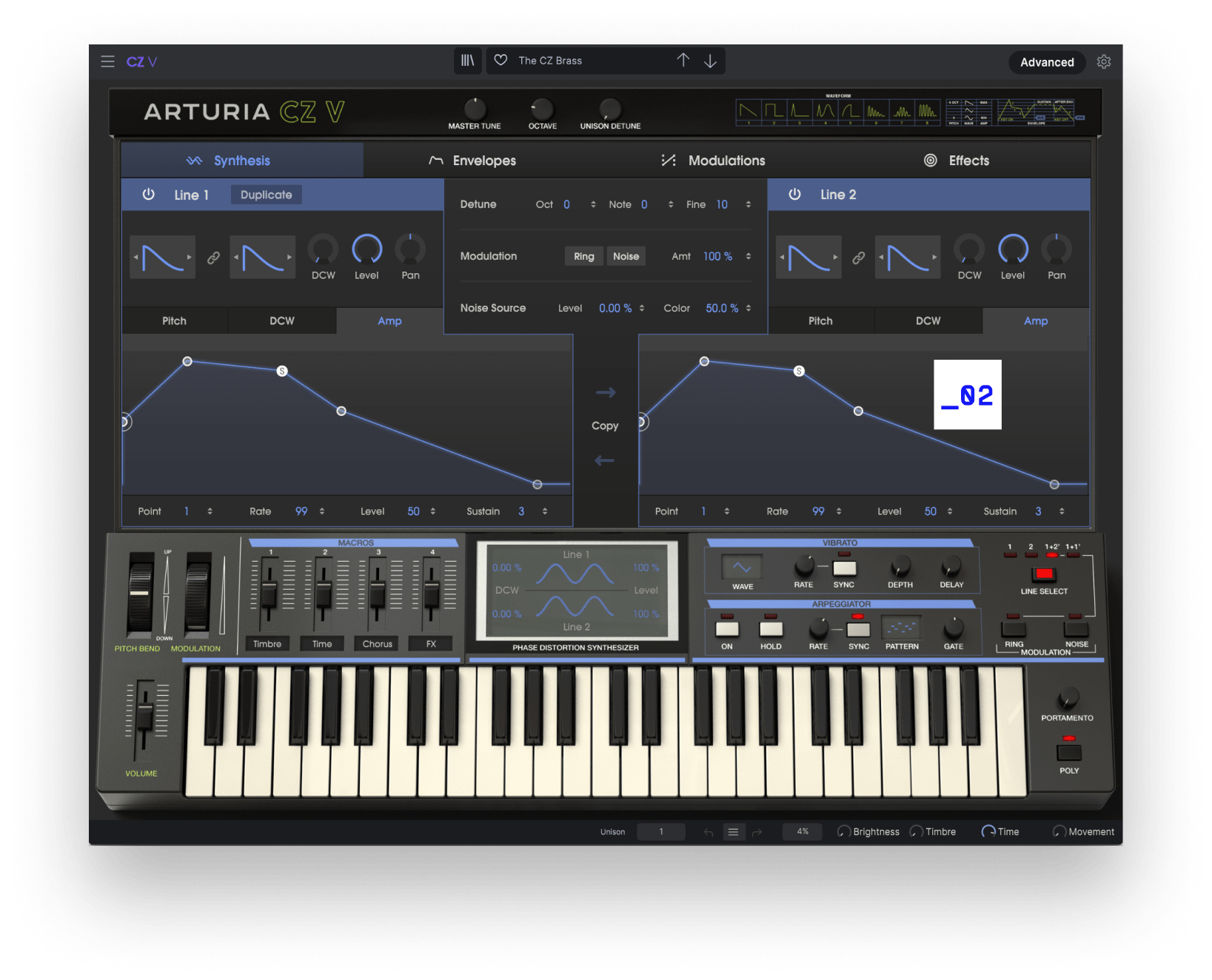
CZ V duplicates the hardware’s eight waveform choices, but if you want something different, just draw and save your own to produce any sound imaginable.
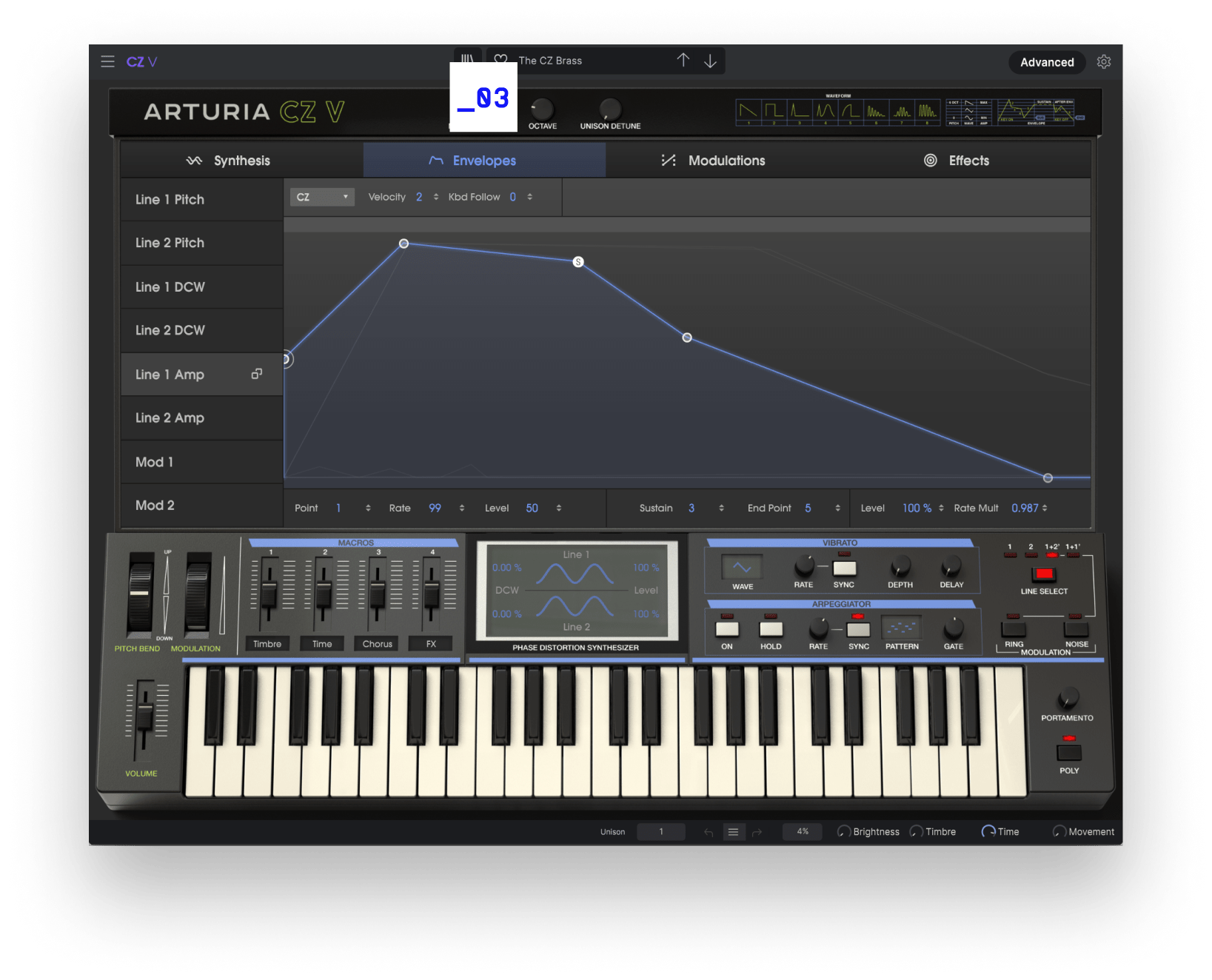
Separate envelopes for pitch, PD amount (DCW), amp, and modulation for each Line power sounds that move, evolve, and interweave.
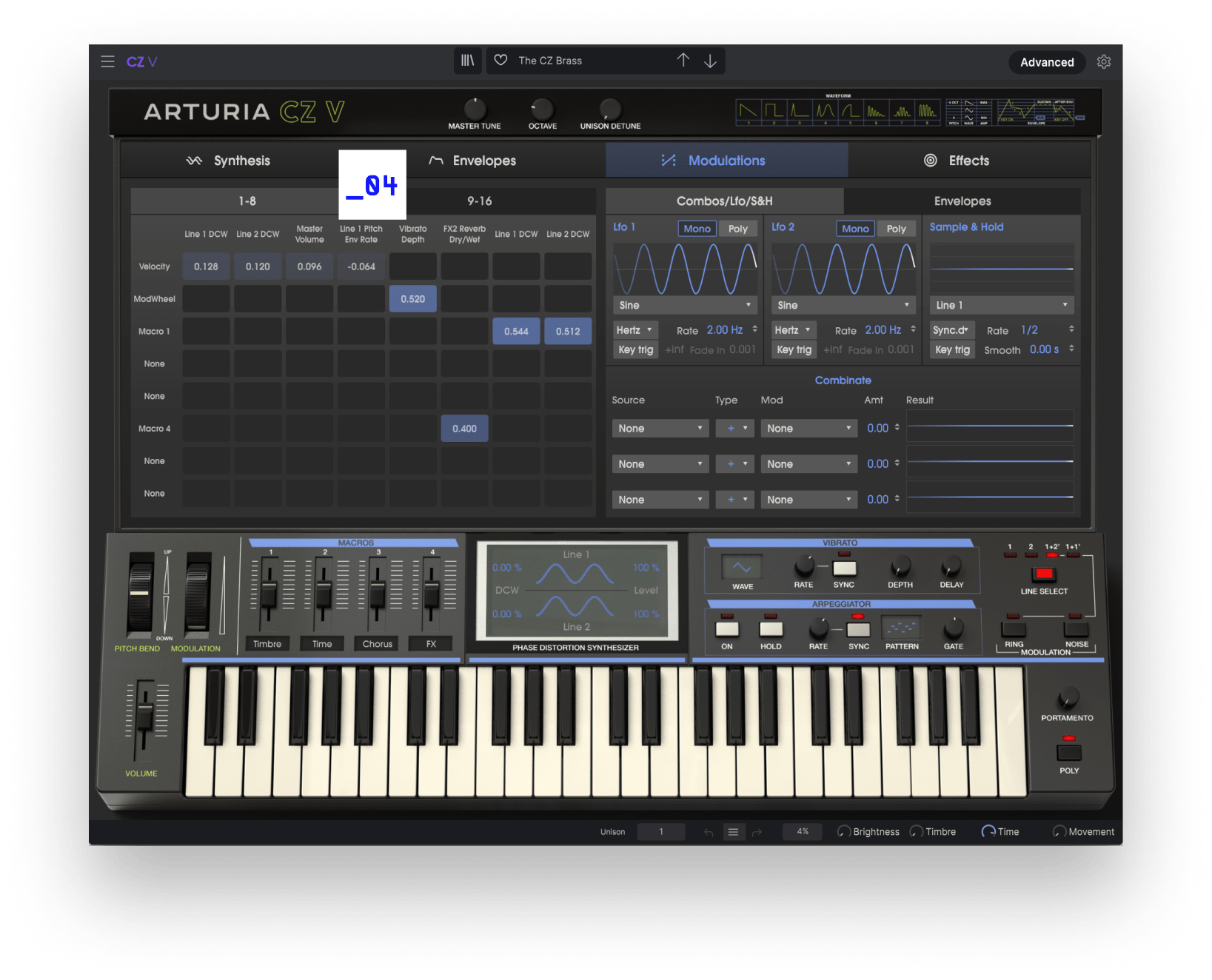
Assign multiple sources including the Macro sliders to a staggering number of destinations here — no hardware CZ had this many modulation options.
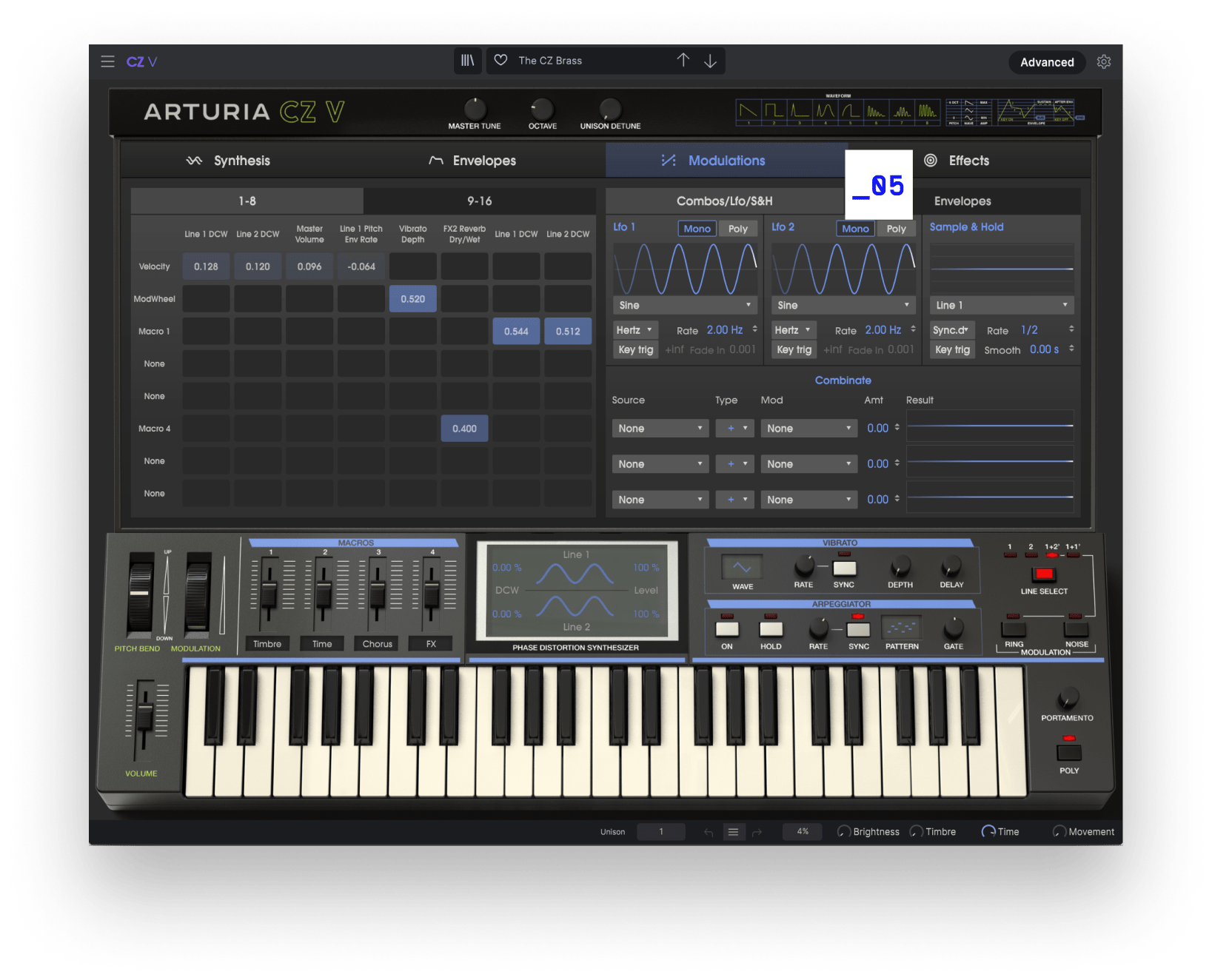
We added assignable LFOs and envelopes. Then, blend any two modulation sources into something completely different using the Combinator slots.

Run Lines 1 and 2 in series or parallel through studio-quality effects. Missing that analog-style synth filter? It’s here!
Hear it
in action
Could someone do an entire album using just CZ V sounds?
Listen to these audio demos from prominent artists and sound designers and judge for yourself. (Hint: We think so!)
Chunky House
Cinematic
DrumBass Desires
Lost Land
Mouvances
Nostalgia
SlowCore
Trance
Tropical Serenade
Presets
CZ V is surprising because it can sound like an analog synth.
It can sound like a DX. It can sound like a PPG Wave. It can generate evocative pads and choirs. And much more. Check out some select highlights from its built-in library of 500+ presets.
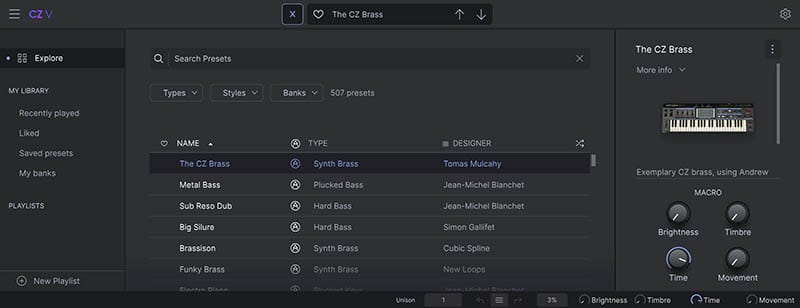
Artistscorner
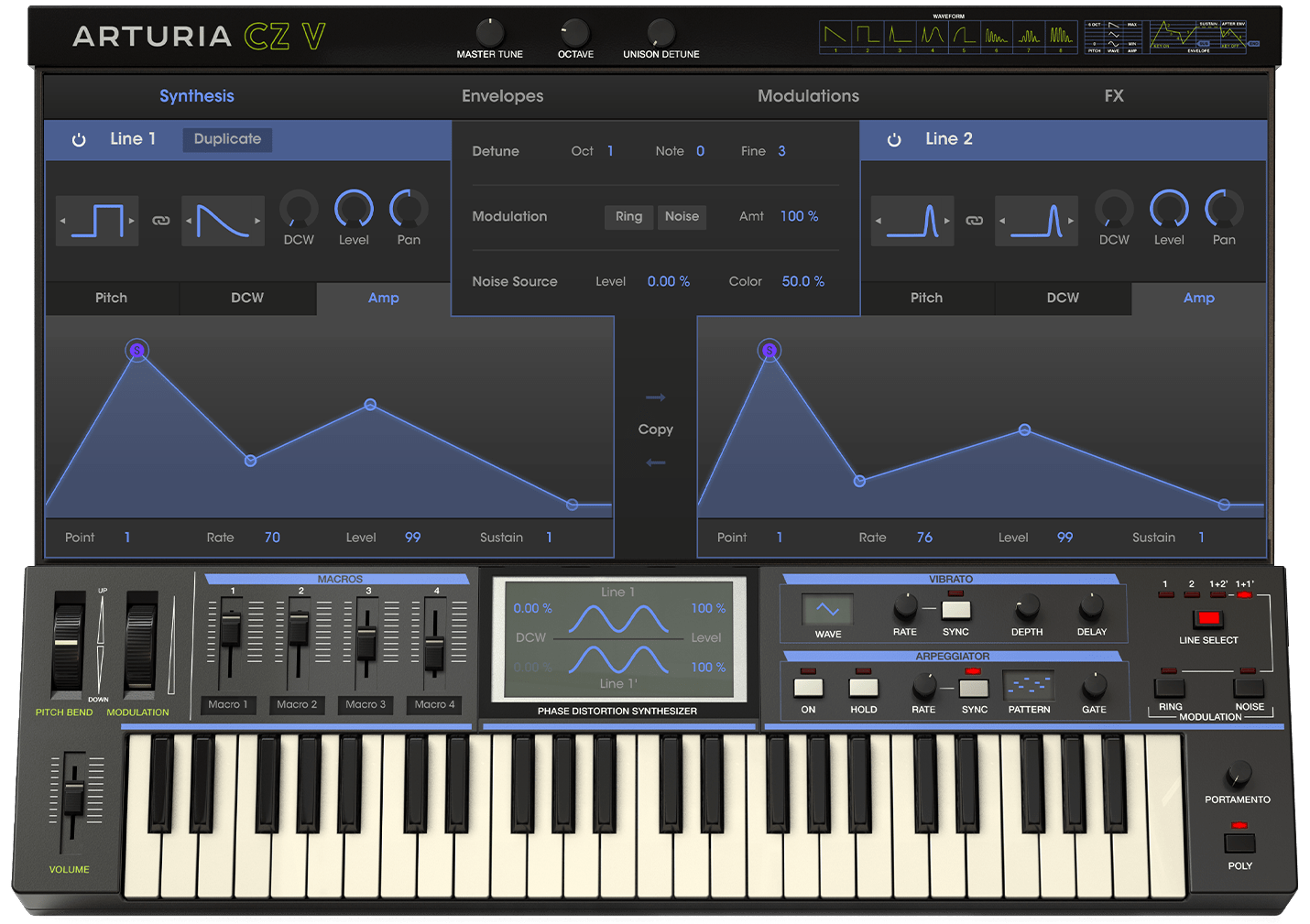
Included in
V collection
Legendary Keyboards Reinvented
This instrument is also part of the V Collection -your complete dream line-up of the legendary synths, organs, pianos and more that made keyboard history. They’re modeled with the most advanced technologies for authentic realism, and enhanced with new creative options. Whether you use it as DAW plugins in the studio or standalone at gigs, V Collection puts the greatest keys of all time at your fingertips for instant inspiration.
Learn More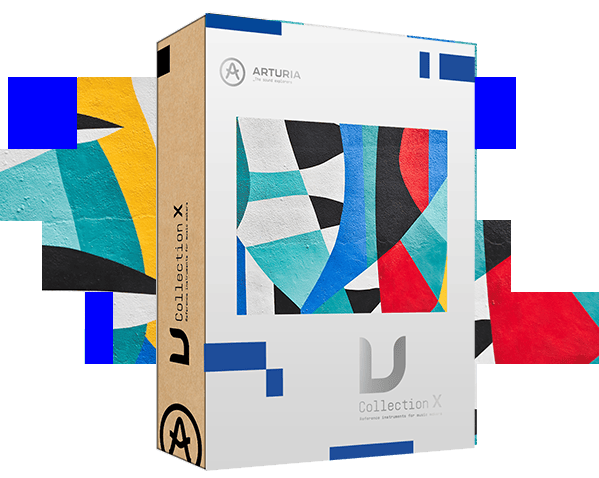
The features
you need

Integrated in-app tutorials guide you through every aspect of the instrument, from individual parameters to tips from our sound designers, so you can focus on the creative stuff. It shouldn't be this easy, but it is!

Arturia Software Center lets you download, organize, and update all of your Arturia software titles in one place, as well as manage all of your licenses across multiple devices. Keep it simple.

Our virtual instruments and plugins are designed to fit right into your setup without hassle. Whatever your style, you can explore sound while enjoying full compatibility with major DAWS, on both Windows and MacOS.

Instantly find the sound that’s in your head with intelligent & streamlined preset browsing. Search with keywords, explore by instrument type, musical style, and more - you can even save your favorites to quickly recall later.

Whether you want the full visual immersion of our classic instrument emulations, or to save precious screen real estate, the interfaces for all of your Arturia virtual instruments can be resized to a scale that suits you.

Instruments come seamlessly mapped for the Arturia KeyLab range - but they’ll place nice with other MIDI controllers too. Instant sound tweaking macros, easy DAW integration, and standalone operation.
Gallery
Main Features
Two synthesis lines and independent noise source
All CZ-101/CZ-1000 original parameters
8 original waveform and custom waveform editor
Original CZ SysEx import
CZ, DADSR and Multi-Segments envelopes (syncable and loopable) to control pitch, DCW and amplitude
2 Modulation envelopes
4 assignable macros
Advanced modulation matrix
A Sample and Hold module, 2 LFOs with 6 waveforms, 3 sources combinators and an Arpeggiator
4 FXs slots that can be routed in serie or per synthesis line
A synthesis line state viewer for real-time feedback
Emulation of the original CZ DAC
32 voices of polyphony
Up to 8 voices of unison with unison detune
Over 400 factory presets
Platform specifications
Windows
- Win 10+ (64bit)
- 4 GB RAM
- 4 cores CPU, 3.4 GHz (4.0 GHz Turbo-boost)
- 3GB free hard disk space
- OpenGL 2.0 compatible GPU
- ARM processors not supported on Windows
Required configuration
- Works in Standalone, VST, AAX, Audio Unit, NKS (64-bit DAWs only).




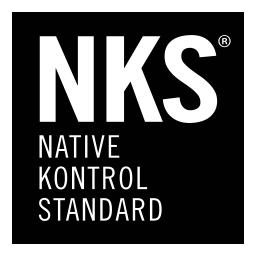
Apple
- Mac OS 11+
- 4 GB RAM
- 4 cores CPU, 3.4 GHz (4.0 GHz Turbo-boost) or M1 CPU
- 3GB free hard disk space
- OpenGL 2.0 compatible GPU
Work with ASC
- An elegant and simple solution to help you install, activate, and update your Arturia software instruments.
All manufacturer and product names mentioned on this page are trademarks of their respective owners, which are in no way associated or affiliated with Arturia. The trademarks of other manufacturers are used solely to identify the products of those manufacturers whose features and sound were studied during the development. All names of equipment, inventors, and manufacturers have been included for illustrative and educational purposes only, and do not suggest any affiliation or endorsement by any equipment inventor or manufacturer.




